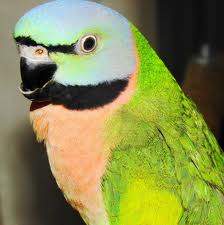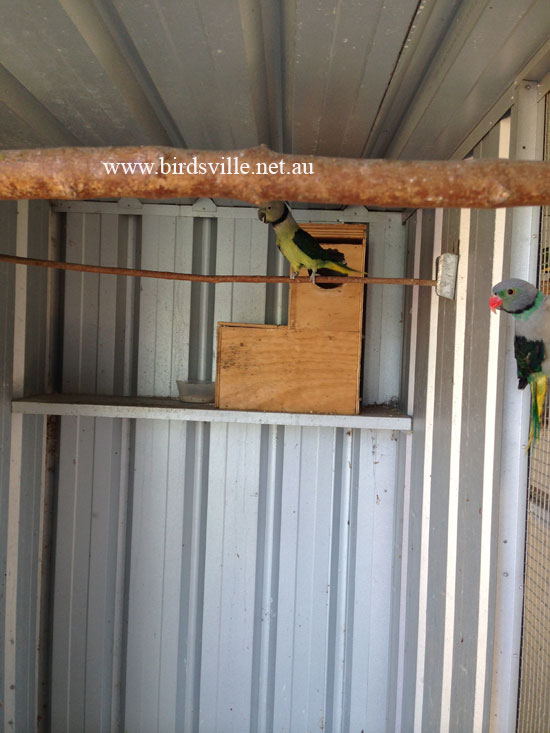Moustache Parrot Guide & Nutrition

Description of Moustache Parrots
A Medium sized parrot around 33 to 44 cm long when fully mature with a weight from 100 to 130 grams when fully grown. The male and the female are easily sexed when mature as they male has a red beak and the females is black. Attractive birds with mostly green plumage with a line across the forehead with a violet blue coloration in the face. The plumage on the upper abdomen, throat and breast is pinkish salmon in color.

Housing for tame Moustache Parrots.
When looking for a cage to house your bird, you want to look for a cage that is large enough for your bird to stretch its wings and have a flap without hitting any toys food bowls of the side of the cage. Your cage must have room for at least 3 to 4 toys and 3 food bowls. Keeping all this in mind buying the largest cage you can afford to make sure your bird remains happy healthy and tame. Staff at birdsville can help you with this selection with our large range of cages in store. Moustache Parrots with the wrong environment or allowed to get bored will in time develop behavior problems such excessive chirping or feather plucking and self-mutilation. It is much easier to prevent these problems than to solve them. Select toys that they can chew on, climb on with different textures like leather and wood, toys that encourage natural foraging behavior or a puzzle they have to solve to get a treat as well as swings bells and ladders. Rotating toys are a good idea, so your bird does not get bored with their toys. Natural tree branches with leaves also provide a good distraction for your bird but remember to clean branches under running water before giving to your bird. If your bird is outside, it is imperative that your bird has sufficient protection from the elements. Direct sun can cook and kill a bird and shelter from the rain is imperative.
Temprement as a pet
The fact is that these birds make wonderful pets with training. Many people are turned off by young moustache parrots as they often become a bit nippy after being weaned due to hormones running through their body. This is common with most parrots in their teenage stage. With the right training and care your bird will soon overcome this stage. So never give up on your bird it is the worst thing you can do. Ring necks that are handled regularly become a very sweet bird with a pleasant nature. These birds are very intelligent so as I said before toys are very important. These birds can also talk.
Moustache Parrots as an aviary bird
These birds mix very well with Asiatic parrots such as Plum heads and Alexandrine parrots. Sufficient flight space is necessary the aviary should be at least a meter wide and 2 meters long with sufficient protection from the elements. Indian ringnecks should never be mixed with much smaller birds as they will easily kill a budgie sized bird or smaller. Always be very careful when mixing species as a general rule only house similar sized birds together. Keep in mind birds that get along can quickly become aggressive around breeding season and even fight to the death.
Introducing your new bird to existing birds
Once you take your bird home you should keep it in a separate cage and allow the bird to adjust accordingly. Always allow at least 2 weeks before introducing the bird to an existing bird.
Worming
Your bird will need to be wormed in a few weeks to two months after being taken home (check with the staff from Birdsville, when purchasing). Young birds that have been recently weaned have a delicate bacteria’s developing in their gut, worming at this stage could harm the bacteria’s development and your new bird. Worming will need to be done.
every 6 months. Worming your bird is essential for the health of all parrots in captivity.
Lice & Mites
These are the two most common parasites of cage birds and their environment but are easily controlled with a Mite and Lice spray, available at Birdsville. When using spray, spray bird, entire cage, perches, nesting box and toys, remember to remove all water and feed and avoid spraying in birds’ eyes. Your bird Lice and mite bottle will explain how to use, remember avoiding the mouth and eyes.
Training Your Bird
Training is an important factor of having a well-behaved hand raised bird. When you first get the bird home, let it settle down and get use to their new environment for a day or two. After these initial days, the bird should be handled in a quiet, relaxed situation. Spending time with your bird while watching TV or reading is perfect, but don’t over stress your bird in the first few weeks of taking it home, babies need their rest. The more time you spend with your bird, the better your bird will become.
When doing any training there are three basic concepts to keep in mind.
- When the bird does something good –> give it a reward.
- When the bird does something undesirable –> ignore it.
- Never punish your bird
Start training your bird with a simple command, like step up.
Have the bird on one hand, place the other hand against the birds’ chest and say the command, step up, as you apply a slight pressure to the birds’ chest. The bird will then put one leg up, pull slightly up with the second hand and the other leg will follow, reward your bird with a treat, like a favorite fruit, seed or nut. Then repeat, as the bird gets better, get it to step up a few times before rewarding. Once your bird catches on to it, instead of rewarding it with food, reward it with praise. This will soon become second nature to the bird.
It is important not to overdo the training, keep it short, but frequent.
Breeding
These birds are relatively easy to breed with a good diet and the right conditions. These birds usually start breeding season for Indian ringnecks in Sydney Australia around august. The female will start showing interest in breeding by spending time in her nesting box. The female basically plays all the cards, and the poor male will do what his told, only joking. But seriously, the female may chase the male but both birds will become very interested and affectionate towards each other. When this happens, it is only a matter of time before the first egg will be laid. Indian ringnecks usually lay 3-5 eggs and incubation lasts an average of 23 days. They fully fledge at seven weeks but are fully dependent on their parents until they are 10 to 11 weeks old.
many breeders take the babies out when they are 2 weeks old, they will lay a second clutch but usually they will have one clutch a year.
Enrichment
Toys are used as a form of environmental enrichment, but enrichment shouldn’t stop there. As an ex-zookeeper it was a major concern that all animals must have a variety environmental enrichment to keep the critters entertained. This is in no way different for anyone who has a tame parrot at home. Enrichment is important because parrots simply cannot thrive with only perches, food and water. The fact is birds provided with enrichment are unlikely to developed psychological problems such as self-mutilation, feather plucking and excessive squawking. Enrichment WILL in fact effect your bird in a positive way with its mental and physical development when training your bird, you will actually end up with a better, less fearful, friendlier and relaxed bird which will be more easily trained. Enrichment can be chew toys, play toys, leather toys, acrylic plastic toys, wooden toys, shredding toys, ropes, swings, ladders, bells, balls, birdie balls, plain card board, small boxes, wicker baskets, tray of wheat grass, plants, bird baths, different foods, food kabobs, nuts, (all available at birdsville) You may also find in your local area pine cones, hide food inside pine cones, twigs, bendy branches, flowers and branches- safe flowers are bottle brush, grevilia, eucalypt melaleuca flowers, hibiscus, marigolds, dandy lions leaves and all, roses, violets to name a few.
Note anything found outside should be disinfected and nonpoisonous and toys must be nontoxic.
Enrichment tip- the trick to keeping them entertained is regularly rotating toys as they will become bored with the same toy in their cage day after day. Changing them regularly will create interest for your bird as if they are receiving a whole new toy to play with.
Diet For the Moustache Parrot
Wild Moustache have a diet that consists of leaf buds, berries, fruits, seeds, insects, nuts and vegetables.
In captivity these birds should have a combination of fruits, vegetables, pellets, a good seed mix, meal worms and nuts. A balanced diet is important for your bird and should not only be fed seed or pellets alone. Birdsville recommends vetafarm nutriblend pellets, vetafarm paradise pellets, Murphy’s Pellets, Harrisons or pretty bird pellets. All Pellets are available at birdsville.
These birds look their best when they are fed on a varied diet of seed, pellets, nuts, fresh fruit and veg such as Broccoli, spinach, carrots, sweet potato, corn, apple, rock melon, beans, orange, strawberries and more. Young birds should be fed an all you can eat buffet of the above foods mentioned.
With Adult moustache parrots reduce the amount of fatty food such as nuts and sunflower seeds. I do this by having one dish of pellets and one of seed. I do not replenish any of the seed or the pellets until they have eaten all their food. Many bird owners fall into the trap of filling up there seed every day and all they do is ignore everything else and just eat the fattiest sunflower seeds. Be brave your bird will eat all their food when left with no choice and your bird after some time will have shiny bright vibrant feathers and be feeling much healthier on the inside as well.
Training moustache parrot’s
Like many Asiatic parrots shortly after the weaning process they can become a little feisty due to the hormones that run ramped through their bodies which in the wild would be essential to give them the edge for survival. This won’t last long and stick to your training, and you will end up with a fantastic parrot with great talking ability.
Medicating Your Moustache Parrot
If you notice your bird has diarrhea which is basically watery feces add dome sulfa 3 of sulphadim to the drinking water. We recommend adding this to your bird’s water anytime you move your bird to a new location. This isn’t so important if the bird is an adult bird as they have a fully developed immune system.
This is a mature moustache parrot
This is a baby moustache parrot notice the lack of colours.
more information coming soon.


